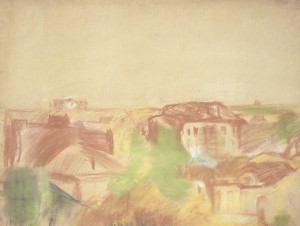The Way of Painting group gave its first exhibition in 1927. The exhibition was held at the Makary Ambrosyevich Prokhorov’s apartment. Prokhorov was acquainted with the artists of the group through Vera Yefremovna Pestel, whose family he was close with, and he came from the merchant class: his father had sold renowned Belyov pastilles in Moscow. Prokhorov loved painting and had tried writing, but in the twenties became a builder (zastroyshchik). The essence of this word is preserved today thanks to Mikhail Afanasyevich Bulgakov’s novel The Master and Margarita. Therein, while in the insane asylum, the hero says the following to a poet who is suspected of having schizophrenia:
…gave up his room on Miasnitskaya… and rented a place from a private builder [zastroyshchik], in an alley near the Arbat.
“you know who these ‘builders [zastroyshchiki]’ are?” the guest asked Ivan and immediately explained: “They’re a small group of crooks who have somehow managed to survive in Moscow…” (Bulgakov, Mikhail. The Master and Margarita. Trans. Michael Karpelson. Lulu Press, 2006).
Builders [zastroyshchiki] authorized to restructure and adapt numerous non-residential premises for habitation when Moscow was undergoing housing shortages: the famous “apartment question.” They divided up entryways, basements, attics and other areas of their own residencies and then rented these out. Obviously Makary Ambrosyevich was not engaged in such activities. His “private apartment” had an extravagant appearance and was well-suited for holding exhibitions. Vera Pestel recalled that there was a glass ceiling in a large room of his apartment, allowing daylight to fall on the paintings.
And so, the exhibition was opened. A manifesto was prepared for its opening: “Our exhibition is the first stage on the way towards assertion of the painted image.
We affirm the formal embodiment of the idea of a subject as the content of such art in opposition to formalists who speak about the idea of a form.
The abstract constructions of formalists and the nebulous pursuits of artists that call themselves symbolists are equally foreign to us: the ways of the first led to the analytic disintegration of an image’s subject while the ways of the second lead to stylization and eclecticism, since by trying to replace the subject with a conditional law both one and the other stepped outside the boundaries of painting and shattered the living image. We analyze the form and don’t replace the subject with a law: we want to create an image that has an independent life, existing in parallel with the subject that exists in the real world. We are searching for art that is realistic both in form as well as in content and subject-matter.



